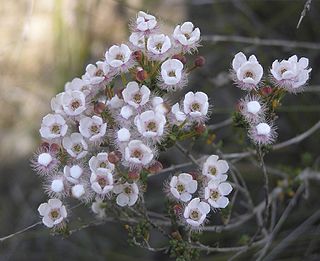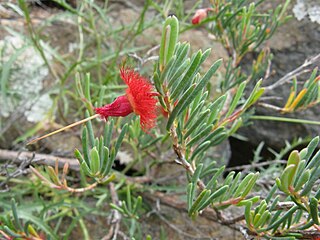
Verticordia huegelii, commonly known as variegated featherflower, is a flowering plant in the myrtle family, Myrtaceae and is endemic to the south-west of Western Australia. It is a sometimes an erect shrub, sometimes sprawling to almost prostrate. It has linear leaves and very feathery flowers in spring. The flowers are usually cream-coloured or white, becoming pinkish and reddish or maroon as the flowers age, giving a variegated appearance to the display.

Verticordia acerosa is a flowering plant in the myrtle family, Myrtaceae and is endemic to the south-west of Western Australia. It is a shrub with yellow flowers which change colour through red to almost black as they age. There are two varieties which vary in their leaf shape, their flower colour and some of the structures in the flower.

Verticordia habrantha, commonly known as hidden featherflower, is a flowering plant in the myrtle family, Myrtaceae and is endemic to the south-west of Western Australia. It is a slender shrub with short, leafy side-branches and long flowering stems with rounded heads of mostly white flowers. Its hairy sepals are mostly hidden by the round, unfringed petals, and as a result, the plant looks like shrubs in the genus Chamelaucium, to which it is closely related.
Verticordia sect. Pennuligera is one of six sections in the subgenus Eperephes. It includes sixteen shrub species in the genus Verticordia. Plants in this section range from small and spreading to large shrubs and have been referred to as "lettuce-leaved" or "round-leaved". The flowers are relatively large, with their sepals having feathered lobes and ear-like appendages on a stalk so that the appendages cover the floral cup. The petals are oval to egg-shaped or round and are usually fringed.
Verticordia subg. Eperephes is a botanical name for a grouping of similar plant species in the genus Verticordia. This subgenus contains six sections, classifying forty four species, of Alex George's infrageneric arrangement. The subgeneric name is derived from the Greek word eperephes, in reference to over-hanging parts at the hypanthium which differentiate the contained species from the other two subgenera.
Verticordia harveyi, commonly known as autumn featherflower, is a flowering plant in the myrtle family, Myrtaceae and is endemic to the south-west of Western Australia. It is a slender, spindly shrub with relatively long leaves and small white, pink or magenta-coloured flowers in late summer and autumn.
Verticordia subg. Verticordia is a botanical name for a grouping of similar plant species in the genus Verticordia. This subgenus contains eleven sections, classifying thirty six species, of Alex George's infrageneric arrangement. A number of anatomical features differentiate the contained species from the other two subgenera.

Verticordia is a genus of more than 100 species of plants commonly known as featherflowers, in the myrtle family, Myrtaceae. They range in form from very small shrubs such as V. verticordina to trees like V. cunninghamii, some spindly, others dense and bushy, but the majority are woody shrubs up to 2.0 m (7 ft) tall. The flowers are variously described as "feathery", "woolly" or "hairy" and are found in most colours except blue. They often appear to be in rounded groups or spikes but in fact are always single, each flower borne on a separate stalk in a leaf axil. Each flower has five sepals and five petals all of a similar size with the sepals often having feathery or hairy lobes. There are usually ten stamens alternating with variously shaped staminodes. The style is simple, usually not extending beyond the petals and often has hairs near the tip. All but two species are found in Southwest Australia, the other two occurring in the Northern Territory.
Verticordia sect. Tropica is one of six sections in the subgenus Eperephes. It includes three species of plants in the genus Verticordia. Plants in this section occur are the only verticordias to occur in tropical areas of Western Australia and the Northern Territory, including the Kimberley and Kakadu National Park and they have the ability to regrow from a lignotuber after fire. They have leaves which vary in size from tiny and pressed against the stem to long and curved but are always linear in shape. The flowers have fringed petals and lobed sepals with small, ear-like appendages and the style has a narrow band of hairs near its tip.
Verticordia verticordina is a flowering plant in the myrtle family, Myrtaceae and is endemic to a small area near the coast of the south-west of Western Australia. It is a small, low-growing shrub with crowded leaves and in spring, scattered pale greenish-cream and golden brown flowers. Its unusual flowers and fleshy leaves give the plant a superficial resemblance to a Darwinia.

Verticordia sect. Verticordella is one of six sections in the subgenus Eperephes. It includes eighteen species in the genus Verticordia. Plants in this section are often small, bushy shrubs with a single main stem and scented flowers. The leaves are linear, usually semi-circular in cross-section and have a hairy or irregularly toothed edge. The flowers are pink, sometimes red to purple, pale yellow or white. They have a floral cup with downward curving appendages, bracteoles which are shed when the flower opens, and sepals with fringed lobes. The petals have a fringed or toothed margin and a curved style that is hairy at the apex.

Verticordia sect. Chrysorhoe is a section that describes three shrub species in the genus Verticordia. The section is one of seven in the subgenus, Verticordia subg. Chrysoma. The three species in this section are inflexible, upright shrubs usually no taller than 2 m (7 ft). They have needle-like leaves and their flowers are arranged corymb-like, sometimes densely on the ends of the branches. The flowers are orange, gold-coloured or yellow and the petals have toothed margins, the anthers have a flattened, swollen appendage and the staminodes are narrow.
Verticordia sect. Synandra is a section that describes a single species in the genus Verticordia. The section is one of seven in the subgenus, Verticordia subg. Chrysoma. The characteristics of this section includes having branches and flower stalks which are covered with stiff, bristly hairs, and stamens and staminodes which are joined at their base in a tube. The subspecies and varieties of the single species in this section all have bright green leaves and superficially resemble dwarf pine trees.
Verticordia huegelii var. stylosa, commonly known as variegated featherflower, is a flowering plant in the myrtle family, Myrtaceae and is endemic to the south-west of Western Australia. It is a single-stemmed shrub with its growth form depending on its surroundings. It is similar to other varieties of the species but differs in its flower colour and the form of the style and staminodes.

Verticordia mitchelliana, commonly known as rapier featherflower, is a flowering plant in the myrtle family, Myrtaceae and is endemic to the south-west of Western Australia. It is a shrub with bright red, rapier-like flowers in spring and early summer, which readily distinguish it from other species. It is commonly grown in private gardens and some forms have larger flowers than those usually found in the wild.

Verticordia ovalifolia, commonly known as oval-leaved featherflower, is a flowering plant in the myrtle family, Myrtaceae and is endemic to the south-west of Western Australia. It is an openly branched shrub with egg-shaped leaves and strap-like, feathery petals in spring.
Verticordia sect. Platandra is one of eleven sections in the subgenus Verticordia. It includes two species of plants in the genus Verticordia. Plants in this section resemble V. pritzelii in section Catocalypta but differ in they do not have tufts of hair on their sepals. The anthers are flattened and the hairs on the style are forked. When Alex George reviewed the genus in 1991 he formally described this section, publishing the description in the journal Nuytsia.
Verticordia sect. Recondita is one of eleven sections in the subgenus Verticordia. It includes a single species in the genus Verticordia. Plants in this section are inconspicuous shrubs with linear leaves which are triangular in cross-section, rather scattered flowers and staminodes tapering to a fine point. When Alex George reviewed the genus in 1991 he formally described this section, publishing the description in the journal Nuytsia. The name Recondita is derived from the Latin word reconditus meaning "concealed" or "hidden" referring to the small size and scattered flowers of plants in this section.
Verticordia sect. Intricata is one of eleven sections in the subgenus Verticordia. It includes three species of plants in the genus Verticordia. Plants in this section are usually bushy shrubs, sometimes cauliflower-like, with greyish leaves and fluffy or woolly pink to red, sometimes white flowers. The sepals have intricately branched lobes and hairy appendages and the stamens and staminodes are joined in a ring structure. When Alex George reviewed the genus in 1991 he formally described this section, publishing the description in the journal Nuytsia. The name Intricata is from the Latin word intricatus meaning "entangled" or "complicated" referring to the intricately divided sepals.
Verticordia sect. Jamiesoniana is one of six sections in the subgenus Eperephes. It includes the single species Verticordia jamiesonii. Plants in this section have tiny, yellowish leaves and white flowers that turn pink as they age and have stamens and staminodes with slightly thickened hairs.







